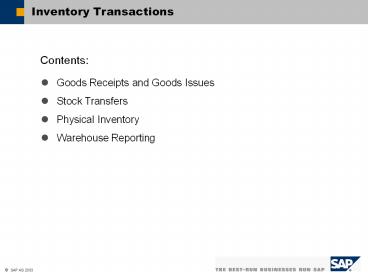Inventory Transactions PowerPoint PPT Presentation
Title: Inventory Transactions
1
Inventory Transactions
Contents
- Goods Receipts and Goods Issues
- Stock Transfers
- Physical Inventory
- Warehouse Reporting
2
Inventory Transactions Unit Objectives
At the conclusion of this unit, you will be able
to
- Post miscellaneous goods movements
- Transfer items from one warehouse to another
- Carry out a physical inventory using SAP Business
One - Outline the benefits of warehouse reports and
explain the differences between them
3
Inventory Transactions Course Overview Diagram
Master Data
Purchasing A/P
Inventory Transactions
Fundamentals of SAP Business One
Sales Opportunities
Sales A/R
Production
Cross-Functionality
4
Goods Receipts and Goods Issues Topic Objectives
At the conclusion of this topic, you will be able
to
- Post goods receipts without reference to a vendor
- Post an initial entry of stock balances
- Enter goods issues that do not refer to a
specific customer delivery - Explain how goods movements are assessed and
accounts determined
5
Stock Movements
Goods Receipts PO/ Goods Returns from
PurchasingFunctions
Delivery/Returns from SalesFunctions
Goods Receipts
Goods Issues
Warehouse
Beginning Quantities
Stock Transferbetween Warehouses
RemoveComponentsfor Production
Goods Receipts fromFinal Product
6
Goods Receipts / Goods Issue
Goods Issue
Goods Receipt
Number
Gen. Information 1
Last Purchase Price
Price List
Account
System Defaults Revenue Account for Goods Receipt
or Expense Account for Goods Issue
Table Window
Remarks
Gen. Information 2
Journal Remark
Special Info for Accounting
Text Information
7
Inventory/Stock Postings
Entering Stock Balance Sheet
Opening Stock Account
Date
Warehouse Name
General Warehouse
Item Code
Item Name
In WH
Op. Balance
Price
0001
Chair
100
10
Opening Stock Account
Stock
C
D
C
D
1000
1000
Stock Balance Sheet
Item/Warehouse
Item Master Data
Warehouse Data
Inventory Posting List
On Stock Desired Stock Minimum Stock
Level MovingAverage Price . ...........
100
10
8
Stock Transfers Topic Objectives
At the conclusion of this topic, you will be able
to
- Post stock transfers in SAP Business One
- Outline the accounting documents created as a
result - Handle scenarios involving consignment stock at a
customer
9
Stock Transfers
CustomerConsignment
Stock Transfer
Customer
Name
Issuing Warehouse for the Entire Stock Transfer
Document
Ship To
From WH
01
Contact
To Warehouse
Item Description
Item No.
Quantity
Price
Total
Price ListAccording to Customer Master
Receiving Warehouse for Each Item
Price List
OK
Cancel
10
Consignment Stock at Customer
Invoice
4.
1.
Delivery
2.
Withdrawal
Production
Customer
Company
3.
SYSTEM
1.
Invoice
2.
WH 03
WH 01
Stock Transfer
Goods Issue from WH 03
Customer
Company
11
Physical Inventory Topic Objectives
At the conclusion of this topic, you will be able
to
- Make preparations in the system to carry out a
physical inventory - Carry out a physical inventory
- Post the differences and ensure that the system
finds the correct expense and revenue accounts
and posts the required values
12
Physical Inventory
Inventory Tracking
Stock Posting
Inventory Tracking
Print InventoryDocuments
Perform Count
Record CountResults
PostDifferences
Hide QuantityStored
StatusNot Counted
Do not AllowPostings
Record theQuantitiesCounted in the Warehouse
Correct Quantities Stored
Status Counted
Profit or Loss as a Result of Inventory
Differences
Item List per Warehouse
Note Results
No Changes in Quantity or Value
13
Inventory Differences
Update After Inventory
- Last Calculated Costs
- By Price List
- By Standard Price/Moving Average Price
Increasing Acc.
Decreasing Acc.
Date
Item Code
Item Description
In Stock
Counted
Difference
Price
00001
1000
1001
1
Inventory/Stock Posting
Enter St. Bal.
Inv. Tracking
Stock Posting
Item Selection
Code From
To
Vendor From
To
Warehouse
Allow Posting without Price
Price Source for WH Stock Posting
14
Inventory Cycles
Menu
Inventory Cycle
Frequency
weekly
Next Alert Date
Inventory
Time
Definitions
...
Inventory Cycle
Item Master Data
Warehouse Data
Inventory Cycle
WH 01
Inventory Cycle Report
All items that are currently scheduled for
inventory count.
15
Warehouse Reporting Topic Objectives
At the conclusion of this topic, you will be able
to
- Outline the benefits of warehouse reports and
explain the differences between them
16
Stock Changes in Logistics
Report Inventory Status
In Stock
-
Sales Orders
Order
AvailableQuantity
Transaction
Goods Receipt
-
-
Goods Issue
Inventory/Stock Posting
Positive Inventory Difference
Warehouse
-
-
Negative Inventory Difference
17
Overview of Warehouse Reports 1/2
- 1. Items List
- Overview of all (or selected) items with the
relevant prices, according to the price lists
stored in the system - 2. Inventory Posting List By Item
- Overview of all the quantity-based postings in
the system, based on various selection criteria
and sort options - 3. Inventory Status
- Overview of the current stock situation of
selected items, and information on planned
receipts and withdrawals in the warehouse - 4. Inventory in Warehouse Report
- Normal Overview of the current stock situation of
selected items including planned receipts and
withdrawals for each warehouse - Detailed Stock overview for each warehouse with
additional information on the last stock
movement data and prices per material
18
Overview of Warehouse Reports 2/2
- 5. Inventory Valuation Report
- In SAP Business One, stock valuations are
generally based on the moving average price. This
report allows you to use a different method to
valuate your stock so that you can manually copy
the results to accounting. - You can display the report from
- The overall item level
- The transaction level for each item
- Valuation Methods
- Moving average price
- FIFO - first-in-first-out
- LIFO - last-in-first-out
- Using a defined price list
- Last calculated costs (value from last warehouse
stock valuation)
19
Inventory Unit Summary
You are now able to
- Post miscellaneous goods movements
- Transfer items from one warehouse to another
- Carry out a physical inventory using SAP Business
One - Outline the benefits of warehouse reports and
explain the differences between them

